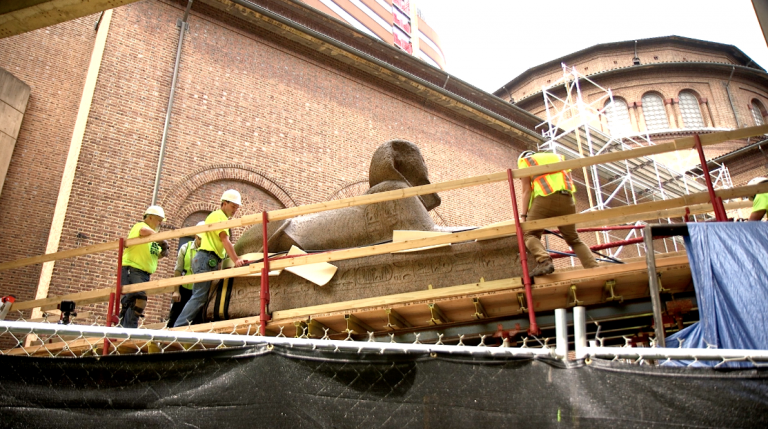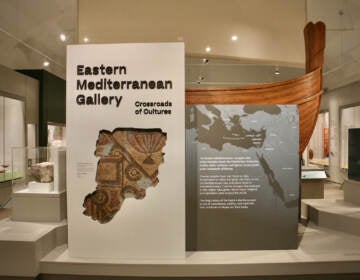Like ‘Back to the Future’: Penn Museum floats its ancient sphinx to a new home
The Penn Museum used “glorified hoverboards” to lift its 13-ton ancient Egyptian sphinx to its new home at the entrance, where it will greet visitors.

The Penn Museum used “glorified hoverboards” to lift its 13-ton ancient Egyptian sphinx to its new home at the entrance, where it will greet visitors. (Kimberly Paynter/WHYY)
The sphinx was never supposed to move from its pedestal.
The 3,000-year-old monument to the Egyptian pharaoh Ramses II stood in the Lower Egyptian gallery of the University of Pennsylvania Museum of Archeology and Anthropology for almost a century.
As the sphinx lay on its lion haunches, the Penn Museum continued to build up around it.
“When it was moved into that gallery in 1924, the wall through which it was moved was opened. Once the sphinx was inside, the wall was closed. It was bricked up,” said Jennifer Wegner, the associate curator of the museum’s Egyptian collection, who wrote a book about the sphinx four years ago. “And then, there were additional museum buildings built against that wall.”
It’s the largest authentic sphinx in North America at about seven feet high, four feet wide, and 13 feet long: much too big to fit through a door.
“But we never considered there was a window,” said Wegner, chuckling, on Wednesday when the museum tackled the enormous engineering feat of moving the 12.9-ton artifact made of solid red granite to a platform at the entrance of the museum.
The job was to hoist the sphinx out of a second-story window, across a courtyard, and into another window on the other side — without damaging the building or the sphinx. The challenge was put to Brian Houghton, the museum’s building engineer.
“We reached out to rigging companies and they said they have this technology called an air dolly system,” he said. “Essentially, it’s like a glorified hoverboard, like from ‘Back to the Future.’”
The sphinx was placed on four pneumatic pads hooked up to an industrial-sized air compressor. The whole thing floated on a buffer of air, all 13 tons of it literally flying two inches above the ground.
It glided, with many hands guiding, along a 200-foot ramp made of scaffolding, steel beams, and wooden planks inclining up to another window on the other side of the courtyard. A manual winch did the pulling as many hands guided it ever-so-slowly, about a quarter inch per second.
Now, the sphinx will greet visitors right when they walk in the front doors of the museum, which is undergoing significant renovations.
“You’ll have one of the most significant archaeological objects in America greeting you as you come in the doors of the new Penn Museum,” said director Julian Siggers.
Not the sphinx’s first move
The sphinx is not unaccustomed to big moves — or to standing sentinel at the entrances of institutions.
It was discovered in 1912 by the British archeologist Flinders Petri during an excavation of the ancient Egyptian city of Memphis, where the sphinx had once guarded a temple, Wegner said.
“It was a being that was designed to protect the temple space, to threaten or ward off any evil that might approach the temple,” she said.
Petri’s expedition was underwritten in part by the University of Pennsylvania, so he offered up his find to the museum.
One year later, the sphinx was shipped by steamer to Port Richmond in Philadelphia, where it was hoisted by a crane onto a flatbed railcar and taken to the end of the line at 23rd and Arch streets. There, it was hooked up to a team of horses and carted across a bridge over the Schuylkill River to the Penn Museum.
Such a gift would be impossible today. Since the 1970s, laws dictate that whatever happens in Egypt, stays in Egypt. Any artifacts discovered during excavations automatically become the property of the country.
The sphinx’s first home in Philadelphia was outside the Penn Museum. However, Philly’s climate is much wetter and colder than Egypt’s, so concerns about exposure to the elements eventually brought it inside. In 1924, it was placed on a pedestal in the Egyptian galleries.
“The sphinx is such an iconic image of ancient Egypt and people have long been fascinated and felt very attached to our sphinx here in the Penn Museum,” said Wegner, who noted there have been wedding ceremonies and children’s sleepovers in front of the artifact over the years.
While the sphinx is one of the most iconic objects of the Penn Museum, it’s not the largest.
The Egyptian galleries contain pieces that comprise an entire Egyptian palace, one owned by the son of Ramses II. Its giant columns, covered in hieroglyphs, lie in sections on the ground.
The museum is in the midst of a major renovation of its entire interior, updating the 19th century stone building with 20th-century amenities, such as air conditioning, access elevators, and proper washrooms.
As part of those renovations, the ancient palace will be reconstructed to its original, 23-foot height. It is expected to be completed in 2022. Other galleries in the museum about Africa and Central America are expected to be completed in November.
WHYY is your source for fact-based, in-depth journalism and information. As a nonprofit organization, we rely on financial support from readers like you. Please give today.





